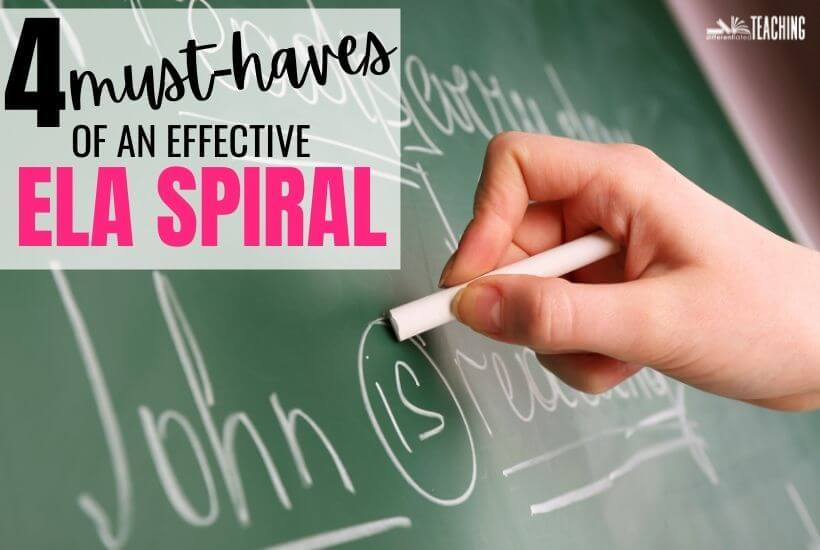4 Key Components of an Effective ELA Spiral Review: Boosting Language Skills for Success
In order for students to be successful readers and writers, they need a strong foundation in language arts. This includes grammar, vocabulary, word analysis/spelling, and editing/revision skills. It can be difficult for teachers to find the time to cover all of these topics effectively during the school year. That’s where spiral reviews come in!

In this blog post, we will explain the four key components of an effective ELA spiral review and why they are so important for student success.
Language & Grammar Skills You Should Find in an ELA Spiral Review
An effective language arts warm-up will include language and grammar skills. This is important because students need to be able to understand the mechanics of language in order to be successful readers and writers.
By reviewing these skills regularly, students will be better able to apply them in their own reading and writing.
Here are four commonly overlooked skills your ELA spiral review should include:
1) Grammar
Many popular curricula currently overlook grammar completely or anticipate that students will learn it incidentally while reading and writing. This is a huge mistake! If students do not learn grammar explicitly, they will not be able to apply it in their own writing.
In order to effectively review grammar, teachers should focus on one skill at a time and provide plenty of opportunities for practice. The goal is to work through the progression of skills from identification to application.
For example, if you are working on subject-verb agreement, start by reviewing the rule with your students. Then, provide them with a variety of sentences to practice identifying and correcting errors. You can also have students create their own examples to share with the class.
Don’t forget to include some fun, too! Grammar doesn’t have to be boring. There are plenty of games and activities that can be mixed into language centers or as a review after you complete your spiral review.
2) Language & Vocabulary
Idioms, analogies, and figurative language are all important parts of language arts. By reviewing these skills regularly, students will become better readers and writers. They are also skills that you can easily incorporate into a daily ELA spiral review!
While students need regular exposure, instruction in this area doesn’t need to take a long time. That is why these make a great addition to morning work or as part of a language arts warm-up. Just a few minutes each day will help students build their skills and confidence.
3) Vocabulary – Spelling Patterns & Morphological Analysis
Understanding phonics and word parts can help both reading and writing. It is also crucial for building vocabulary. While it is becoming more clear that many popular curricula overlook the importance of explicit instruction in this area, more and more schools are requiring phonics and morpheme instruction.
However, students often need more than one exposure to really master these skills. Incorporating these into an ELA spiral review allows students the opportunity for repeated practice with decoding, encoding, and building a deeper understanding of common word parts.
Practice with prefixes, suffixes, and Greek or Latin roots offers advantages for both spelling and vocabulary development. By including these skills in your spiral review, you will help students become better readers, writers, and spellers!
4) Editing & Revision
Finally, it is important to give students consistent opportunities to apply their understanding of grammar, language, and conventions in context. While it can be difficult for students to effectively edit their own writing, practicing with pre-written sentences can be a great start.
Looking for errors and correcting them is an important skill that will help students become better writers. It is also a great way to review all of the other language skills you have been working on!
Starting with single sentences and working on adding capitalization and punctuation is great for elementary learners. As the year progresses, they can work to revise for clarity and interest and work on editing longer passages as well.
Incorporating this into your morning work or as part of your ELA spiral warm-up means all students have a shared experience that you can use as a hook for adding these practices into their own writing.
Getting Started with a Daily ELA Spiral Review
I’ve incorporated all four of these critical language skills into my Daily Language Spiral in order to help ensure I’m building the foundational skills my students need for success.
Doing so has been an easy way to get more from my writing block, and it has allowed me to easily fill gaps in the curriculum provided by the districts I’ve worked in. Now I use it with my own kiddos as part of our homeschool routine and during summer to reinforce the lessons I’ve taught and get some daily independent practice.
By incorporating these four key language arts skills into your daily spiral review, you will give your students the opportunity to practice and master them. Not only will this help with their reading and writing, but it can also prepare them for standardized tests. These are essential skills that all students need in order to be successful.
Are you ready to get started? Click your grade level to grab two free weeks of my ELA Spiral Review and see if it’s a great fit for your learners!












